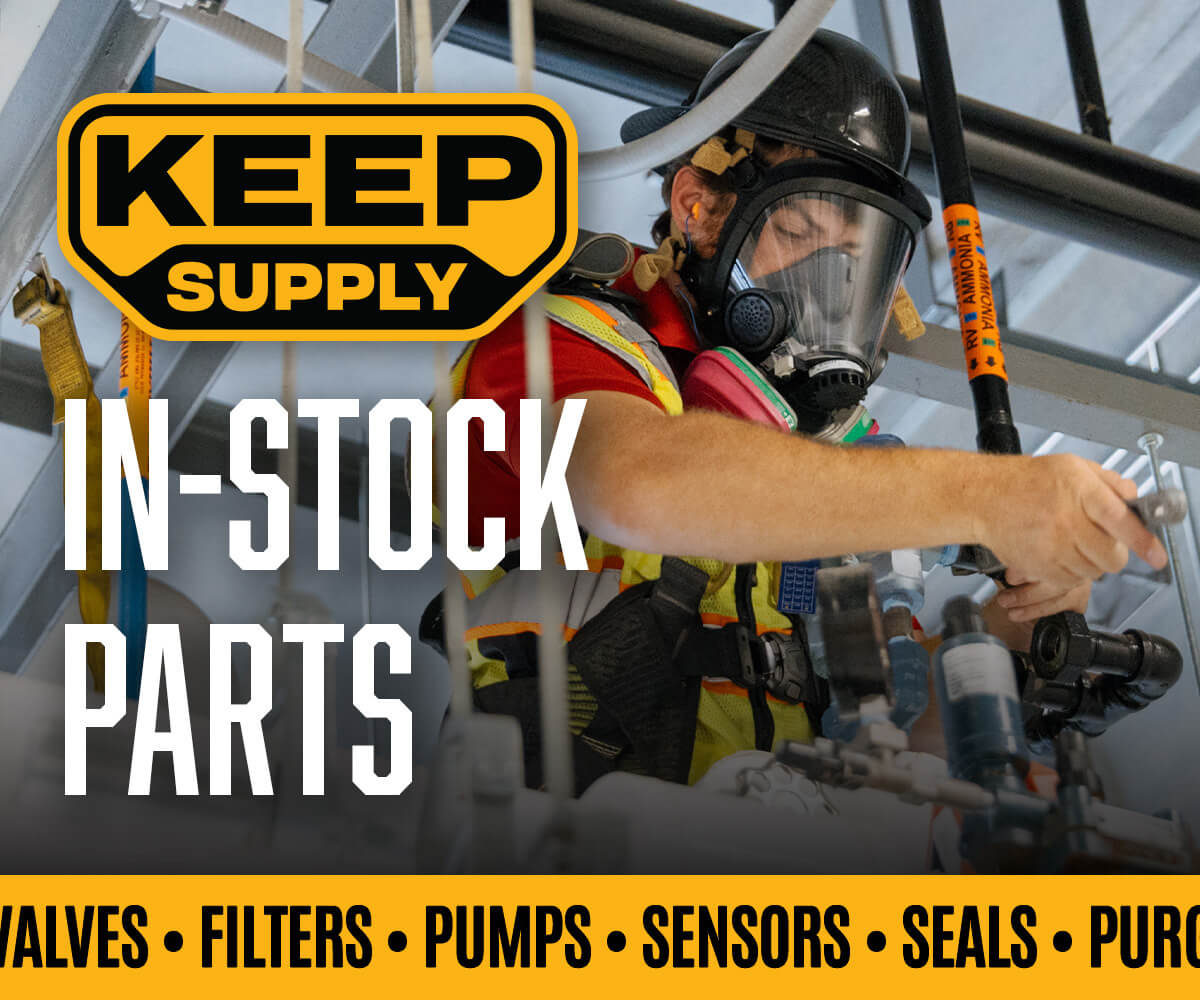Advancements in Refrigeration Equipment Require Advanced Lubricants
A major factor driving the change has been regulatory requirements, which have led to increasing numbers of end-users seeking low-global warming potential refrigerants, such as ammonia and CO2 , which in turn has produced more options and greater competition in the refrigeration space.
There is no one-size-fits-all lubricant that can be used in every application, said Jalesh Kalra, general manager/commercial, for CPI Fluid Engineering, a division of Lubrizol Corporation. “You want to get the best product and check all the boxes: cost, efficiency, performance,” Kalra said, adding that low-charge ammonia systems and ammonia/CO2 transcritical systems are gaining more and more ground. “There could be many drivers for a particular compressor type.”
Based on the application and compressor type, lubricant selection varies depending on factors such as working conditions, compressor efficiency and life expectancy, compressor cost and metallurgy, and the refrigerant being compressed.
Jalesh Kalra, general manager, commercial, for CPI Fluid Engineering.
Based on the application and compressor type, lubricant selection varies depending on factors such as working conditions, compressor efficiency and life expectancy, compressor cost and metallurgy, and the refrigerant being compressed. All of those factors directly affect the decision of which lubricant formulation works best to deliver the expected results related to compressor performance, Kalra explained.
“There is a lot more customization, more operating conditions and proliferation of more refrigerants. The market also demands greater agility,” said Flavio Kliger, Lubrizol’s general manager/ industrial formulated fluids and greases. “Proliferation adds complexity. In the past, it was much easier to recommend a lubricant based on fewer parameters.”
Carbon dioxide and ammonia are making their way into a wider variety of commercial and industrial applications, with a wider variety of operating conditions, said Mike Costello, strategic research and innovation director for CPI Fluid Engineering.
“Since the operating envelope for CO2 and ammonia has expanded, we have a broader range of requirements to investigate. Currently, we’re researching ways to make lubricant formulations that would eliminate the need for the manufacturer to make a mechanical change,” Costello said. He added that manufacturers today have to know more about the operating conditions to produce the most effective lubricant.
“A lubricant we developed five years ago doesn’t necessarily work in newer systems, so we may need to adjust the base stock and additive chemistries to meet the new requirements,” Costello said.
Glenn Short, president of BVAdvanced Products, a division of BVA, Inc., said that historically, mineral oils were used over 100 years, but that has changed. “The changes were initially in the refining of the mineral oil over the years,” he said. It is essential for those in the industry to understand how changes in equipment and refrigerants affect the lubricants, which can also be called working fluids.
“To a lot of these guys, refrigeration oil is refrigeration oil,” Short said. “They practically think the mineral oil and polyol ester are the same thing. It never occurred to them that they couldn’t use them the same way.”
Synthetic hydrocarbons such as polyalphaolefin (PAO) oe alkylbenzene (AB) offer improved performance due to having superior lower temperature properties and less volatility. Polyalkylene glycols (PAG) and their end-capped polyether can be used where miscibility is required. CO2 applications require lubricants such as the capped polyalkylene glycol or polyol ester (POE) to be miscible. HFC and HFO refrigerants primarily use polyol esters, polyvinyl ether (PVE), or in some cases polyalkylene glycols or their capped derivatives. Hydrocarbon refrigerants may use any of these lubricants.
Refrigeration lubricants have several jobs to do. They must lubricate bearings and compressor parts and act as an oil seal for the compressed gas, Short said. They also sometimes must act as a heat transfer fluid and therefore can’t create any heat-transfer problems. They also need to be stable with the refrigerant, which can sometimes require additives, and be compatible with various materials, such as elastomers and metal. Using a polyol ester in an ammonia system produces viscous sludge or rubber-like solids.
The right lubricants play a critical role in ensuring new technology can work as it should. “It is always an ecosystem. The refrigerant manufacturers, the refrigerant supplier and the compressor manufacturers all have to move together and not independent of each other,” said Jalesh Kalra, general manager, commercial, for CPI Fluid Engineering. “They all have to fall in place for a new design to work.”
When a new technology comes out, it affects all parties in the lubricant supply chain, including oil producers and the lubricant manufacturers. CPI closely monitors evolving technology and works closely with equipment manufacturers to meet their needs.
Jalesh Kalra, general manager, commercial, for CPI Fluid Engineering.
A lubricant is made up of a base oil and an additive package, and there are a variety of base oils that can be used depending on the application, Kalra said. Base oils could include polyalkylene glycols, mineral oils, polyol ester or a blend of alkyl benzene and mineral oil. Selection of these oils will very much depend on what specific application the lubricant is intended for. “Having a complete base oil ‘toolkit’ is necessary for a supplier to tailor the lubricant products to the specific needs of global customers,” he said.
When a new technology comes out, it affects all parties in the lubricant supply chain, including oil producers and the lubricant manufacturers. Suppliers must closely monitor evolving technology and works closely with equipment manufacturers to meet their needs.
“There are many good solutions but there is no one best solution that works for all applications. Everyone is trying to find the right solution for their application,” Costello said, adding that lubricant suppliers also have to keep an eye on costs and ensure a lubricant doesn’t become too expensive.
Equipment manufacturers will often approach lubricant manufacturers with information about new compressors they’re developing and the operating conditions. “We may have to adjust the base stock and additive chemistries to operate in the window they’re proposing” Costello said. “There are a lot of new conditions coming out. If you have too much refrigerant solubilized in the lubricant, it may be too thin and create wear. Conversely, if you don’t have enough, it may be too thick and create efficiency losses.”
Short said his company likes to work with the compressor designer/manufacturer whenever possible. “If they are developing a new machine, they’ll talk to lubricant suppliers that they feel have the expertise in their area,” he said. “They’ll say, ‘We are going to use this refrigerant, and we’d like it to have these technologies.’”
Short said he sees the need for a broader understanding of the range of viscosities available. Refrigerants affect the operating viscosity of lubricants. “Once it is in the compressor, it is a lubricant within a dissolved fluid,” he explained. “It mixes with the CO2 or the ammonia. The result of that is different for each refrigerant and each lubricant type and is also dependent on operating conditions.”
While the refrigerant is in a gaseous state in the compressor, it is a liquid in the condenser and evaporator. Short said lubricant manufacturers consider the seal for the compressed gas. “The objective is to get the gas from lower pressure to higher pressure. The resulting viscosity for how much the oil dilutes can affect efficiency,” he said. “As the gas is compressed, you have the heat from the compression, and the oil is heating up. Most designs they want to cool the oil back down.”
That means the lubricant can become a heat transfer fluid, so lubricant manufacturers have to know the heat-transfer properties of the oil. “The oil has to be stable with that refrigerant. You don’t want it to react or break down because of the refrigerant,” Short said.
Miscibility, the property of two substances to mix and form a homogeneous solution, can affect how much oil accumulates in the evaporator. “It is a whole system we have to think of, not just a compressor,”
Short said. He added that lubricants can create heat-transfer problems. “You also have to make sure the additives in formulated lubricants don’t create problems, such as plugging a capillary.” Short said the most critical element with CO2 is stability. “CO2 does react with water and make carbonic acid. Acids, in general, break down lubricants the fastest,” he said. It is possible to remove the acid with additives, but those additives are expensive.
Higher pressure tends to be hotter, which results in less thermal stability. “That’s usually addressed between the base stock and additive chemistry,” Costello said.
Short said CO2 is an unusual animal. “Oils at one temperature might be heavier than liquid CO2 , but at another temperature, they’re lighter,” he said. “It makes the whole task a lot more difficult.”
Typical CO2 systems operate at high pressure. “It doesn’t affect the lubricant as much as it affects the system,” Costello said. “The traditional lubricants we used for CO2 are very soluble and significantly lower the working viscosity.”
That means manufacturers have to be aware of the working viscosity of the lubricant. “You have to use a lubricant that is not going to be too soluble,” Costello said.
On the other hand, ammonia is the opposite of CO2 because it is not very soluble in traditional lubricants, Costello said. “The idea is to increase the polarity of the lubricant to try to make it more soluble in the ammonia, so you don’t have a lubricant that carries out of the compressor sump into the system, which can cause efficiency loss or worse” he said. “We’re trying to formulate a lubricant that gives you the right solubility.”
Kliger said lubricant manufacturers have to find the right balance of miscibility to optimize wear and efficiency. “If it is too soluble, it carries too much, and you lose efficiency. If it carries too little, you get wear,” he said.
Ammonia equipment manufacturers have found some equipment isn’t as compatible with traditional lubricants as they had expected. “Ammonia is not miscible with mineral oil or other hydrocarbon oils,” Short said. “Designs with DX evaporators require a lubricant with higher miscibility to prevent the accumulation of the lubricant in the evaporator. We have developed miscible lubricants to solve the evaporator issues that also have the correct balance of viscosity and solubility for the compressor.”
Short said price is the No. 1 driver in the ammonia industry, and equipment manufacturers always want to know how much improvements to mineral oils will cost.
Kalra said end users need to be sure their lubricant supplier has strong supply chain capabilities. “It isn’t just about getting the right product. It has to be available where it is needed, reliably and globally,” he said, adding that suppliers need to be able to produce the lubricants, ramp up production and deliver on quality consistently, in the packaging needed with resilient supply chain backbone.















